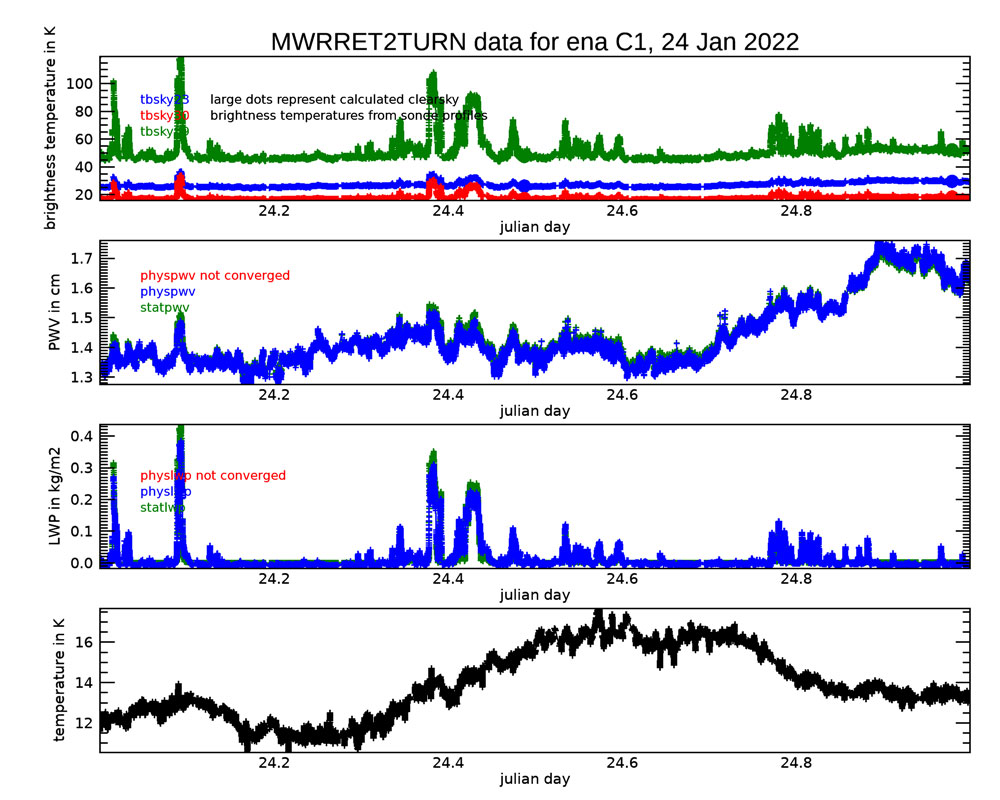New Microwave Radiometer Retrieval Data Available for Eastern North Atlantic
Published: 10 November 2022

The Microwave Radiometer Retrievals version 2 value-added product (MWRRETv2 VAP) has been processed from January 2021 through July 2022 at the Atmospheric Radiation Measurement (ARM) user facility’s Eastern North Atlantic atmospheric observatory.
Liquid water path (LWP) and precipitable water vapor (PWV)—important variables to understanding radiative transfer in the atmosphere and clouds—are typically retrieved from microwave radiometers. MWRRETv2 is an updated version of mwrret1liljclou—documented in Turner et al. 2007—that extends the physical optimal estimation retrieval of LWP and PWV to microwave radiometers beyond ARM’s original standard 2-channel systems (23.8 and 31.4 GHz).
The LWP retrieval from MWRRETv2 is critical to understanding clouds with low LWP.
MWRRETv2 applies the Turner et al. (2007) optimal estimation retrieval of LWP and PWV to measurements from 3-channel microwave radiometers. These radiometers provide time-series measurements of brightness temperatures at 23.8, 30, and 89 GHz. The 89 GHz channel provides additional sensitivity to liquid water, especially at low LWPs.
In addition, MWRRETv2 includes uncertainty estimates. The 2-channel microwave radiometers give an uncertainty in the retrieved LWP of approximately 25 g/m2. The 89 GHz channel in the 3-channel microwave radiometer has approximately three times the sensitivity to liquid water compared with the 31.4 GHz channel, thus improving the LWP accuracy when the LWP is less than 100 g/m2.
MWRRETv2 applies bias corrections to the brightness temperature data on a daily basis, using an automated bias correction process calculated across a 90-day rolling window.
Scientists can use the new data now. More information about MWRRETv2 can be found on the VAP web page.
Please send questions or comments about the data to ARM translator Damao Zhang.
Access the MWRRETv2 data in the ARM Data Center. (Go here to request an account to download the data.)
To cite the data, please use doi:10.5439/1566156.
Reference: Turner DD, SA Clough, JC Liljegren, EE Clothiaux, KE Cady-Pereira, and KL Gaustad. 2007. “Retrieving Liquid Water Path and Precipitable Water Vapor From the Atmospheric Radiation Measurement (ARM) Microwave Radiometers.” IEEE Transactions on Geoscience and Remote Sensing, 45(11), 10.1109/tgrs.2007.903703.
Keep up with the Atmospheric Observer
Updates on ARM news, events, and opportunities delivered to your inbox
ARM User Profile
ARM welcomes users from all institutions and nations. A free ARM user account is needed to access ARM data.


















